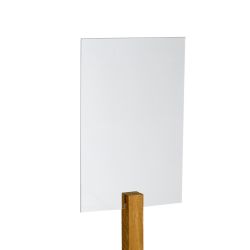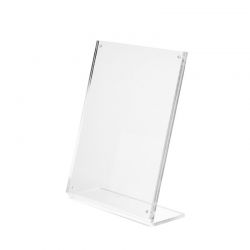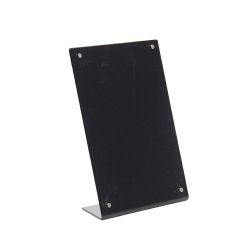Visual holders
What you need to know about PLV's visual holders and tools
Are you a merchant or service provider, and you want to attract more customers? Are you planning to organize a trade show? Are you planning to run aninformation and awareness campaign for a cause you care about? Among the many solutions at your disposal is the use of posters, posters, posters, and many other PLV tools (advertising at the point of sale). In any case, regardless of the solution chosen, the purchase of a poster holder remains a must. So how do you choose the visual holder that will really meet your needs, among the many products on the market? We invite you to find out what you need to know about PLV posters and tools in the following lines.
The characteristics of the poster holders
The poster holder, also known as a visual holder,refers to a communication medium that can accommodate a poster, poster, or poster. Many products are labelled "poster holders": the display frame, the poster cover, the counter bridge, the plexiglass display, the sidewalk stop, the Plexiglas desk,the poster holder, the kakémono holder, etc. To name a few! Let's take a closer look at the different poster models, their manufacturing materials, and the interest in PLV tools. Etiq also offers a wide range of door labels..
The types of poster doors
There are different kinds of poster holders. And they come in different formats and materials. Among the most commonly used types of visual carriers are:
- The panel and the bulletin board (plastic, aluminum, wood, cardboard, plexi, etc.): in portrait or landscape mode, to be placed indoors or outdoors, the panels are used to display documents (service notes, practical information, etc.). There are two types of billboards: the wall panel and the pole-mounted panel. Among the various models of billboards and billboards are, among others, the LED panel for indoors or outdoors, the magnetic bulletin board, etc.
- The poster door frame (aluminium, wood): product to be placed or hung everywhere (wall, door, window, etc.), with an eye-catch in portrait or landscape mode. Visual format: from A0 (80 x 120 cm) to A6 (10.5 x 14.8 cm). Many models available: LED light frame, aluminum frame on foot, secure frame (with or without key), waterproof frame, two-sided suspended frame, window frame, click-clack frame, etc.
- The display pouch (leather, wood, PVC, plexi): a product to be placed, hung or hung. Visual format: from A3 (29.7 x 42 cm) to A7 (7.4 x 10.5 cm). Models: adhesive pouch, anti-reflective pouch, flap pouch, magnetic pouch (use on all metal surfaces), repositionable adhesive pouch with magnetic opening (simplified insertion of the visual), perforated pouch, etc.
Not to mention many other types of poster doors such as the display, easel, sidewalk stop, poster desk, or urn. Note that these products can be delivered with an assembly kit,and be accompanied by many accessories (fixing screws, hooks, etc.).
Poster holder: manufacturing materials
When it comes to the materials used to make the poster doors, you'll find them in:
- Plexi.
- Plastic.
- Leather.
- Wood.
- Cardboard.
- Pvc.
- Metal (aluminium, steel, etc.).
- Etc.
Attention! For display on display or outdoors,be sure to choose a visual holder made of a material that is resistant to sunlight and weather. Plexi and PVC are among the recommended materials for such use.
Interest in PLV tools
The PLV (at the point of sale) allows a company to showcase its products and commercial offers. Its objective is toattract prospects to the place of sale, and to promote theact of purchase. Among the most popular PLV tools are:
- The displays on-foot or countertops.
- Signs and display frames.
- The stop-rays and the stop-trottoirs.
- Interactive screens and kiosks.
- Advertising display in the shop window.
- The brochure doors (walldocument holder - carrying brochure on the ground)
- The kakemonos.
- Etc.
Note that thePLV display also allows a company to deliver messages and information to its prospects.
Poster holders: who are the users?
The poster doors are for everyone. They are used in both private and professional settings. For example, in homes,decorative posters can embellish the doors and walls of the living room and bedrooms. They also brighten up festive events (birthdays, weddings, promotional balls, etc.).
But posters can also be used to promote an activity or cause. Thus, in a professional or associative setting,posters and signage, whether advertising or informational, are thus very present in:
- Places of sale (shops, shops and shopping malls, restaurants, hotels, real estate agencies, travel agencies, etc.).
- Sites open to the public (leisure centres, museums, tourist spots, etc.).
- Medical and social structures (hospitals, clinics, medical practices, etc.).
- Schools.
- Local authorities and public services.
- Professional environments (reception desks, stands, trade shows, showrooms, etc.).
- The events organized by the associations.
- Etc.
In short, visual carriers are practically used by all industries and in countless situations.
How do I choose your poster holder?
The choice of a poster holder will depend in large part on thelocation dedicated toit. If some products are to be placed, on the counter for example, others are intended to be hung or hung. A round-up of a few visual holders, divided by location type.
For indoor viewing
- Poster holder to be placed (on the table, counter, etc.): table easel, magnetic plexi block, countertop display, pedestal pouch (plexi, wood or aluminum), poster door frame, etc.
- Poster holder on or to be placed on the floor: billboard, kakémono holder, poster desk, display, kakémono holder, etc.
- Wall poster: perforated pouch, LED frame, LED light wall panel, etc.
- Hanging poster holder: perforated pouch, etc.
- Door poster door holder: visual cover, poster frame, etc.
For a display in a shop window
- Poster pocket.
- LED light frame.
- Poster kit suspended by cable.
- Etc.
For an outdoor display
- Display panel (window).
- Stop-trottoir.
- Kakémono carrier.
- Etc.
In short,you're spoilt for choice when it comes to poster holders, no matter what the final location is. And as every visual holder comes in many styles, you'll find shoes at your feet.

 English
English  Français
Français

























